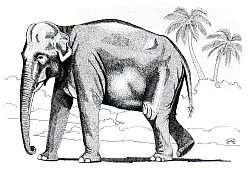English: Asian Elephant; French: Eléphant d’Asie; Abor: Sitte; Akas: Atche; Annamite: Con voi; Bahasa Jawa: Gajah; Bahasa Sunda: Gajah; Bengali: Gaj; Bothias: Lambochi; Burmese: Tseng; Cantonese: Cheong; Chinese: Cheo’h, Xang; Chu: Supo; Gonds: Yani; Hindi: hathi; Kachari: Migung; Karens: Kahsa; Kashmiri: Haust; Khamti: Tsang; Kheh: Geong; Kukis: Saipi; Lepchas: Tengmu; Malabari: Kunjaram; Manipuri: Samu; Nagas: Sotso, Supo, Chu, Tsu; Persian: Fil; Singhalese: Ata, Allia; Singpho: Magui; Sundanese: gajak; Tamil: Ane; Thai: Chang; Talain: Tsing; Telegu: Hattanga, Konga, Eniga.
 |
Former distribution: Mesopotamia east through Asia; India into China to the Yangtze Kiang valley; also in Java.
Present distribution: India, Sri Lanka, Bhutan, Nepal, Bangladesh, Burma, Thailand, Malaysia, Sumatra, Borneo, Vietnam, Laos, Kampuchea and Yunnan in China.
Behaviour: Preferred habitat: lowland and mountain forests (both rain and deciduous), savanna and grasslands; diet includes grass, leaves and fruits; activity both diurnal and nocturnal. They are gregarious.
Population status: Endangered; stable only in national parks. Total 33-38 000; India, Bhutan and Bangladesh 9-15 000; Andaman Islands 30; Assam 4-8000; Borneo 2000; Burma 5000; China 100; Kampuchea, Laos, Vietnam 3500-5000; Malaysia 3-6000; Nepal 50; Sri Lanka 2000-4000; Sumatra 2800-4800; Thailand 2500-4500. Decreasing everywhere.
Brief notes:
Body weight: Up to 5000 kg
Head and body length: 500-650 cm
Tail length: 120-150 cm
Shoulder height: 250-300 cm
Gestation period: 607-641 days
Maximum age: 60 years, up to 80 years in captivity
Trophy: Tusk RW’s: 161, 160 pounds, 1921 India, H.M. KING GEORGE VI; average 40 pounds. SCI: 97 pounds, Malaysia, TUNGKU KUDIN. 46, 44 3/4 pounds, Malaysia, WILLIAM HAY; average 30 pounds.
Hunting methods: Stalking, on elephant back. Almost everywhere protected by law.
Subspecies: 4
1. Elephas m. maximus Sri Lanka. Endangered.
2. Elephas m. bengalensis Nepal, India, China, Burma. Endangered.
3. Elephas m. sumatranus Sumatra, Java, Borneo. Endangered.
4. Elephas m. hirsutus Malaysia. Endangered.
Remarks: The reasons for the steady decline are habitat destruction, deforestation, and conflict with man. The Asian Elephant has been used for timber hauling and hunting for centuries; it is still being so used. Operations for catching elephants still go on in most countries. Severe losses are normal.






